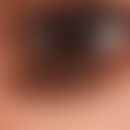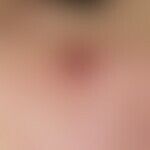Synonym(s)
HistoryThis section has been translated automatically.
DefinitionThis section has been translated automatically.
Common, mostly after minor injuries, but also spontaneously developing, rapidly exophytic, benign vascular tumor of the skin and mucous membranes close to the skin.
You might also be interested in
ClassificationThis section has been translated automatically.
Clinical and histological classification:
- Classic granuloma pyogenicum
- Epulis gravidarum of the gingiva
- Subcutaneous and intravascular granuloma pyogenicum (histological diagnosis)
- Disseminated (eruptive) granuloma pyogenicum (multiple small mostly aggregated nodules)
- Granuloma pyogenicum with satellitosis (especially in children and young adults; recurrent tumor with synchronous flare-up of multiple satellite nodules)
EtiopathogenesisThis section has been translated automatically.
Frequently occurring after trivial injury, with subsequent development of an exuberant, vascular granulation tissue; frequent in pregnancy. Apparently BRAF and RAS mutations play a role in the pathogenesis of this "reactive" and thus benign tumor.
ManifestationThis section has been translated automatically.
Common during pregnancy (epulis gravidarum of the gingiva) with postpartum involution.
Age of first manifestation: rare in the 1st year of life; most common in the 2nd-5th decade of life.
LocalizationThis section has been translated automatically.
Mainly lips, scalp, face, fingertips, tongue, palm and toes, less frequently localizations in the area of the oral mucosa. An esophageal localization has been described (Suarez-Zamora DA et al. 2018).
Clinical featuresThis section has been translated automatically.
1.0-3.0 cm in size, rarely larger, solitary, soft, spherical, slightly bleeding, red, blue, or black, sharply demarcated papule (nodule).
Usually absent to little pain.
As it grows, there is usually constriction of the base, which is bordered by the epidermis in a collar-like fashion. The surface is often eroded, weeping, later ulcerated, and possibly covered with a bled-in black crust.
Differentiate "uncomplicated" granuloma pyogenicum from (rare) bacterial nailfold angiomatosis, which is more likely to be associated with reactive granulation tissue in unguis incarnatus.
Also belonging to the lobular capillary hangiomas of the granuloma pyogenicum type are the rare eruptive disseminated cases (satellitosis), which may occur after incomplete removal of the "primary tumor". In these cases, osseous destruction has also been described. In this respect, the dignity of this rare form of manifestation remains questionable.
HistologyThis section has been translated automatically.
Exophytic, multilobular, mature cell (CD31+) capillary tumor in papillary and reticular dermis. Absent or only thin epithelial covering. Numerous small or larger vascular spaces with clusters of erythrocytes. In the upper parts of the tumor, there is often a vigorous accompanying inflammatory reaction with neutrophilic granulocytes and lymphocytes in the presence of edematous connective tissue stroma. In sections, especially in the deeper parts, also solid tumor nodules with only a few vascular spaces. Numerous mitoses (Ki-67 positivity is significantly increased), moderate endothelatypia. In late stages widened septa with regressed vascular parenchyma.
DiagnosisThis section has been translated automatically.
Differential diagnosisThis section has been translated automatically.
Complication(s)This section has been translated automatically.
TherapyThis section has been translated automatically.
Progression/forecastThis section has been translated automatically.
Great tendency to ulceration with bleeding tendency. If left untreated, granuloma pyogenicum may shrink after several months. A soft fibromatous papule remains as a relic. The recurrence rate after incomplete removal is high.
LiteratureThis section has been translated automatically.
- Baran R (2002) Pyogenic granuloma-like lesions associated with topical retinoid therapy. J Am Acad Dermatol 47: 970
- Exner V et al (2001) Sebaceous gland carcinoma of the neck. Dermatologist 52: 147-149
- Groesser L et al (2016) BRAF and RAS mutations in sporadic and secondary pyogenic granuloma. J Invest Dermatol 136:481-486.
- Holbe HC et al (2003) Surgical pearl: ligation of the base of pyogenic granuloma--an atraumatic, simple, and cost-effective procedure. J Am Acad Dermatol 49: 509-510.
- Kocer U et al (2003) Intravenous pyogenic granuloma of the hand. Dermatol Surg 29: 974-976
- Mazereeuw-Hautier J (2003) Pyogenic granuloma within unilateral dermatomal superficial telangiectasia. Br J Dermatol 148: 823-824.
- Mensch A et al (2007) Multifocal eruptive epithelioid cellular hemangioma of lobular capillary type (granuloma telangiectaticum type). derm 13: 124-128.
- Musumeci ML et al (2013) Two pediatric casesof pyogenic granuloma treated with imiquimod 5% cream: combined clinical and
- dermatoscopic evaluation and review of the literature. G Ital Dermatol Venereol 148:147-152.
- Poncet et Dor A (1897) De la botryomycose humaine. Rev der Chir (Paris) 18: 996-997.
- Purwar P et al (2015)'Granuloma gravidarum': persistence in puerperal period an unusual presentation. BMJ Case Rep 9 doi: 10.1136/bcr-2014-206878.
- Raulin C et al (1997) Granuloma pyogenicum--removal with the CO2 laser. Dermatologist 48: 402-405
- Raulin C et al (2002) The combined continuous-wave/pulsed carbon dioxide laser for treatment of pyogenic granuloma. Arch Dermatol 138: 33-37
- Suarez-Zamora DA et al (2018) Esophageal pyogenic granuloma: A Case Report and Review of the Literature. Int J Surg Pathol 26:735-738
- Taira JW et al (1992) Lobular capillary hemangioma (pyogenic granuloma) with satellitosis. J Am Acad Dermatol 27: 297-300.
Incoming links (26)
Angiokeratomas, acral pseudolymphomatous childhood; Angioma, eruptive; Angioma, proliferative; Bacillary angiomatosis; Contagious ecthyma; Diffuse dermal angiomatosis; Fibroxanthoma atypical; Gemmangioma; Granuloma pediculatum; Gravidarian epulis; ... Show allOutgoing links (8)
Angiosarcoma (overview); Co2 laser; Excision; Gravidarian epulis; Hemangioendothelioma epitheloides; Melanoma cutaneous; Neodymium yag laser; Unguis incarnatus;Disclaimer
Please ask your physician for a reliable diagnosis. This website is only meant as a reference.























